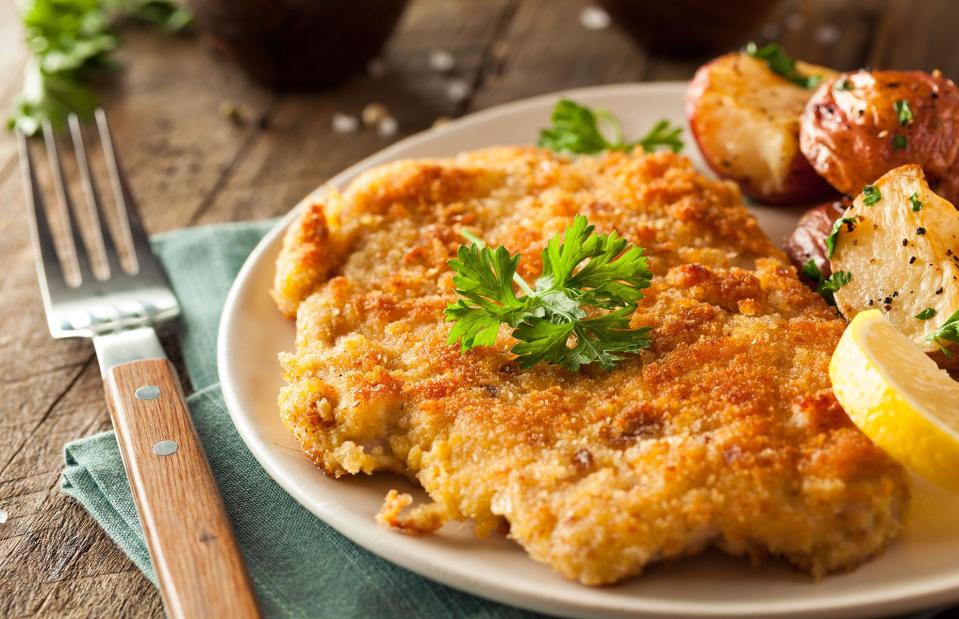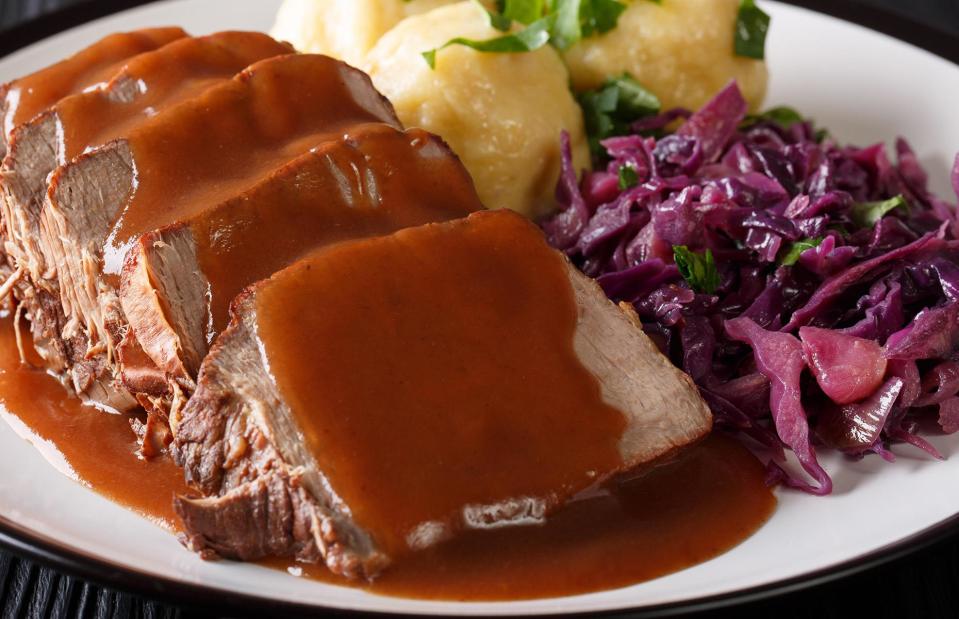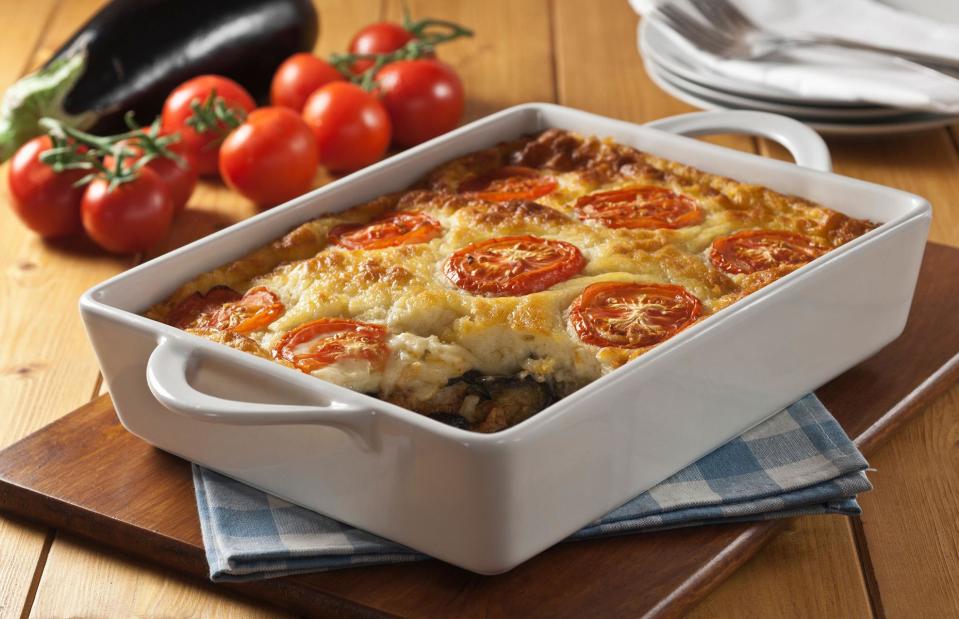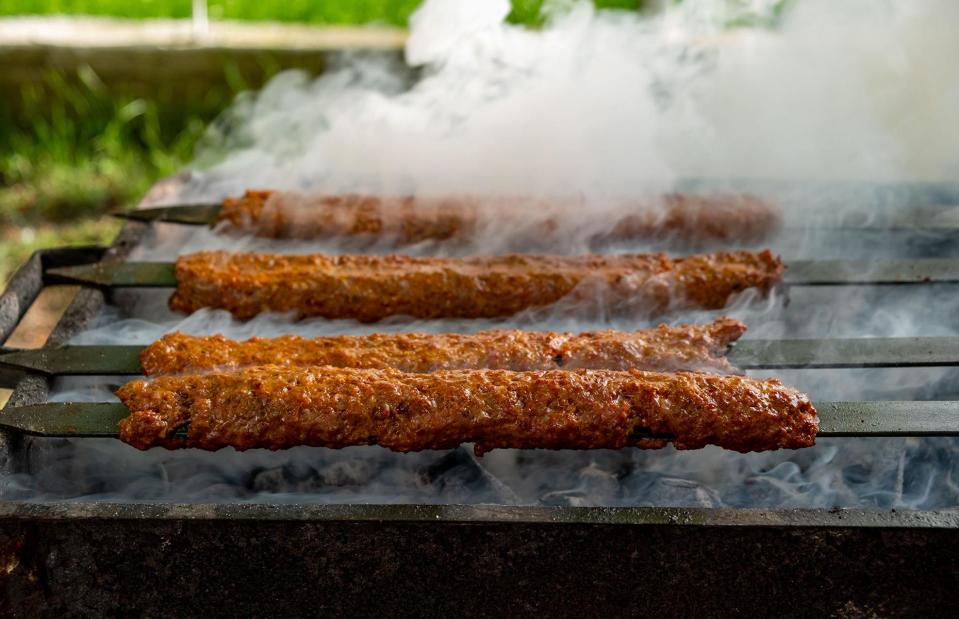Europe's top national dishes you MUST try
A food tour of Europe

Haluk Cigsar/Alamy Stock Photo
Europe is filled with diverse countries and delicious cuisines, all of which have their own unique blend of cultural, historical and geographical influences. From the hearty, winter-proof foods of Scandinavia to Mediterranean meals made with the finest sun-soaked produce, we've narrowed down Europe's best national dishes. Each so woven into the culinary fabric, it seems to sum up the country in one plate (or in one bowl).
Read on to discover Europe's top national dishes that you must try.
Tavë kosi, Albania

Zoonar GmbH/Alamy Stock Photo
A dish of baked lamb and rice, tavë kosi is not only the national dish of Albania, but it's also a symbol of the country's hospitality, often cooked for special guests. The dish's name literally translates to 'yogurt casserole', and it's made by combining lamb, yogurt, garlic, rice and eggs, then baking until the top is crispy and golden.
Wiener schnitzel, Austria

Brent Hofacker/Shutterstock
Many interpretations of wiener schnitzel are cooked in homes and restaurants around the world – but the original, traditionally served with boiled potatoes or a light potato salad, is unbeatable. The dish is made by pounding a veal cutlet until super-thin, then tossing it in flour, whipped eggs and breadcrumbs. The secret to the perfect crispy coating? The schnitzel must be shallow-fried in clarified butter or lard. Figlmüller in Vienna is said to have been serving the original wiener schnitzel since 1905.
Moules frites, Belgium

Natalia Lisovskaya/Shutterstock
A dish that originated from Belgium's Flemish coast, moules frites – mussels with fries – is so popular that the average Belgian eats around five pounds (2.2kg) of mussels every year. The dish has many variations, including moules marinière (with white wine, shallots, parsley and butter), moules nature (with celery, leeks and butter), and moules à la bière (with beer instead of white wine).
Ćevapi, Bosnia and Herzegovina

Peter Forsberg/Food/Alamy Stock Photo
These dinky sausages are beloved across Bosnia and Herzegovina. To make them, beef and lamb mince is hand-mixed with spices, formed into kebab shapes, then cooked under a grill. Ćevapi is typically served on a flatbread with accompaniments like chopped onions, a thick clotted cream–like spread called kaymak, and ajvar: a tangy relish made from roasted red peppers.
Shopska salad, Bulgaria

Simon Reddy/Alamy Stock Photo
If Bulgaria had an official national dish, it would undoubtedly be shopska salad. The perfect refreshing meal to enjoy during the country's hot summers, the salad is a simple mix of chopped tomatoes, cucumbers, onions and roasted or raw peppers. The ingredients are seasoned with salt, drizzled with sunflower oil and finished with a sprinkle of grated sirene (a brined, feta-like cheese). Created in the 1950s, the dish is named after the frugal Shopi people from the Shopluk region of Bulgaria.
Fasolada, Cyprus

ALFA KAPPA/Alamy Stock Photo
This wholesome soup is considered by many to be the national dish of Cyprus. Made with white beans and a mix of vegetables, and served with plenty of olive oil, the dish is traditionally associated with the ancient Pyanopsia festival, held in honour of the god Apollo. Vegetables such as onions, carrots and celery are usually sautéed for the soup base, and the broth is enhanced with tomato paste and a pinch of paprika.
Vepřo knedlo zelo, Czechia

Sergii Koval/Alamy Stock Photo
Literally translated, vepřo knedlo zelo is an abbreviation for roast pork, dumplings and sauerkraut. The pork shoulder (vepřo) is roasted with spices, crushed garlic and caraway seeds, while the sauerkraut (zelo) is sautéed until it's nice and soft. Everything is served with sliced bread dumplings (knedlo), along with a rich gravy made from the roasting juices.
Stegt flæsk, Denmark

Sergii Koval/Alamy Stock Photo
Consisting of fried pork belly slices, boiled potatoes and a simple parsley sauce, stegt flæsk is a traditional rural Danish dish, with roots that can be traced all the way back to the 18th century. A staple in Danish home kitchens (especially during the country's cold winters), the warming meal is typically eaten at least once a week. In fact, the dish is so popular, the Danes are known for eating the most pork in the world, with each person consuming almost 154 pounds (70kg) of the meat every year.
Verivorst, Estonia

Simon Reddy/Alamy Stock Photo
This Estonian blood sausage is another typical winter dish – and it's especially popular during the festive season, when it's roasted with potatoes and pork. Similar to Spanish morcilla or British black pudding, verivorst is made from pigs' blood, combined with pork, barley, onions, allspice and marjoram. It's usually served with butter, sour cream and sauerkraut, as well as a zesty relish made from cranberries or lingonberries.
Karjalanpiirakka, Finland

Ryhor Bruyeu/Alamy Stock Photo
With roots that can be traced back to ancient times, this savoury pie – made with a rye pastry crust – originates from the region of Karelia, shared between Finland and Russia. These days, the pie's filling usually consists of a rice mixture, and the whole dish is served with a topping made from chopped eggs and butter. Historically, ingredients such as buckwheat, potatoes and barley were also used. Protected under European law, the pie has Traditional Speciality Guranteed status, which means it can only be called karjalanpiirakka if the traditional recipe is followed.
Pot-au-feu, France

Sergii Koval/Alamy Stock Photo
Singling out just one national dish to represent France is tricky, but many agree it should be the simple meal of pot-au-feu. Slow-cooked and comforting, this hearty stew – made by slow-cooking beef and vegetables in a large iron pot – encapsulates traditional Gallic cuisine. The origins of the dish are murky, but can be traced back to the 12th century, or potentially even Roman times.
Sauerbraten, Germany

Sergii Koval/Alamy Stock Photo
Although Germany doesn't have an official national dish, sauerbraten could be its most iconic. To make it, beef is brined – often for days – in a mixture of vinegar, red wine, water, herbs and spices, then pot-roasted and served with a rich gravy. Legend has it that medieval emperor Charlemagne invented the dish in the 9th century as a clever use-up for leftover meat. The dish has regional varieties, too; for example, in the Rhineland region, raisins are often used in the sauce.
Moussaka, Greece

Simon Reddy/Alamy Stock Photo
It may be a Greek icon, but moussaka's origins stretch beyond the borders of Greece, with strong influences from Turkey. The modern Greek version, created in the 1920s, is a layered, lasagne-like dish of aubergines, meat sauce and creamy Béchamel. It's now found in most Greek tavernas around the world, and is cooked in Greek home kitchens on a near weekly basis.
Goulash, Hungary

ScotStock/Alamy Stock Photo
Though it's enjoyed with potatoes or rice in across Europe, traditional Hungarian goulash is actually a soup, often served in a carved-out loaf of bread. Traditionally, it's made with either beef shin, shank or shoulder, along with vegetables like carrots, peppers and celery (but never potatoes). The broth is cooked slowly, and seasoned heavily with another signature Hungarian ingredient: paprika.
Irish stew, Ireland

Slawomir Fajer/Shutterstock
A warming, hearty dish starring two much-loved ingredients, meat and potatoes, a traditional Irish stew usually consists of lamb, onions, spuds and carrots. The winter staple is slowly cooked in a pot for hours, until the meat is tender and falling apart. Modern variations sometimes also use the most Irish of ingredients – stout – to give an even richer flavour to the sauce.
Ragù alla bolognese, Italy

Angelika Heine/Alamy Stock Photo
The humble ragù alla bolognese is largely considered the country's most iconic culinary creation. The classic dish hails from Imola, a small town near Bologna, and is said to have been invented in the 18th century. Authentic Italian versions only use a little bit of tomato paste to flavour the minced meat, which is sautéed with sofritto (a mix of finely diced celery, onion and carrot). Most importantly, no garlic is ever used. The key to the best ragù alla bolognese is low and slow cooking, which allows the flavours to develop.
Grey peas and speck, Latvia

Simon Reddy/Alamy Stock Photo
Traditionally a Christmas dish, this hearty bowl is one of few Latvian recipes that's authentically Latvian, and not influenced by the powers that once ruled the country. Grey peas (similar to chickpeas) are soaked and boiled, then stewed with fried onions and cubed smoked speck (a type of fatty bacon similar to Italian porchetta). As the dish is quite filling, it's usually only really eaten during the holidays; however, historically, it was a staple dish for men working in the fields.
Cepelinai, Lithuania

Simon Reddy/Alamy Stock Photo
A uniquely Lithuanian dish, these potato dumplings are hearty and filling – perfect for snuggling up with during freezing Baltic winters. They're most commonly filled with minced meat, but vegetarian options are also widely available. Named for their resemblance to airships (cepelinai translates to 'Zeppelins'), the dumplings are boiled, then served with sour cream and bacon crumbs.
Fårikål, Norway

Simon Reddy/Alamy Stock Photo
As colder weather descends on the country, Norwegians get their casseroles out to make a much-loved winter staple: fårikål, or lamb and cabbage stew. It's so popular that it even has its own national day, on the last Thursday of September. Traditionally, the dish consists of just four ingredients: mutton, cabbage, salt, and whole black peppercorns. However, modern versions tend to replace the mutton with lamb, add carrots or use beer in the sauce. The stew comes served with thin crispbreads and lingonberry jam on the side.
Pierogi, Poland

Arkadiusz Fajer/Shutterstock
One of Poland's most famous exports, pierogi are synonymous with Polish cuisine. Though they're just one of many types of dumpling found throughout the world, pierogi stand out due to their versatility. Made by encasing a sweet or savoury filling in a thin dough, they can be boiled or pan-fried. Popular fillings include meat and onions, sauerkraut, berries and sweet curd cheese.
Bacalhau, Portugal

Simon Reddy/Alamy Stock Photo
Pastéis de nata aside, no food embodies the spirit of Portugal (not to mention its close relationship with the ocean) more than bacalhau, a delicious fish dish created in Lisbon's Bairro Alto neighbourhood. It's even lovingly called fiel amigo, or 'faithful friend'. It's said that there are 365 ways to prepare it – one for every day of the year. The basic recipe is simple: cod is left to dry in salt overnight, flaked, then combined with eggs, sautéed onions, potatoes and spices.
Sarmale, Romania

Fabrizio Troiani/Alamy Stock Photo
Different types of cabbage rolls may be eaten in many countries around the world, but in Romania they're considered the national dish. It isn't clear how cabbage rolls first became part of Romanian cuisine, but the name sarmale comes from the Turkish word sarmak, meaning 'roll'. Sarmale are mostly made with pickled cabbage leaves for an intense, sour and salty flavour, with a traditional filling of pork mince, rice, onions and herbs.
Gibanica, Serbia

nada54/Shutterstock
A type of cheese pie, gibanica is made by layering filo pastry with a mixture of cheese, milk and eggs. The humble dish can be served at practically any time of the day, and is an integral part of Christmas and Easter feasts in Serbia. It's so popular in its home country that a local proverb says: "If there is cheese and butter, my mother knows how to make the gibanica."
Idrijski žlikrofi, Slovenia

Matyas Rehak/Alamy Stock Photo
The national dish of Slovenia, idrijski žlikrofi is named after the town of Idrija, where it was invented in the mid-19th century. The small, dumpling-like delicacies are made by filling pieces of dough with potato, then moulding them into a parcel shape. It's such a staple food that it's been awarded protected status by the Slovenian government, and it's best enjoyed with a bakalca stew made from mutton or rabbit.
Paella, Spain

Suzy Bennett/Alamy Stock Photo
Although it's said there are as many types of paella as there are villages in Spain, paella Valenciana is often regarded as the country's national dish. It has ancient roots, but its modern recipe started taking shape in the 19th century, when workers used to cook rice and seafood in a pan over an open fire. The original version is typically made with chicken, rabbit and even snails, while the 'mixta' version can also incorporate seafood. A notable absence is chorizo – often erroneously added by non-Spanish chefs, but frowned upon by locals.
Köttbullar, Sweden

AY Images/Alamy Stock Phot
Made famous the world over by IKEA, interestingly enough, köttbullar – Swedish meatballs – aren't actually Swedish; the popular national dish is said to have originated from Turkey. In the 18th century, King Charles XII brought the recipe back from his travels, and now the dish is has become a Swedish icon. The meatballs are traditionally served with a creamy, gravy-like sauce, lingonberry jam and mashed potato.
Raclette, Switzerland

Stefano Politi Markovina/Alamy Stock Photo
Much of Swiss cuisine was created with the ritual of après-ski – having a warming drink and hearty food after hitting the slopes – in mind. Raclette is one of several national dishes, rosti and fondue among them, that the Swiss enjoy. Originating from the canton of Valais, it's traditionally made by heating up half a cheese wheel on one side, until it's melted enough to be scraped over a dish of potatoes, cornichons and pickled onions. These days, slices of raclette cheese are melted in special pans found in almost every Swiss household.
Adana kebab, Turkey

Haluk Cigsar/Alamy Stock Photo
Just one of more than 100 types of Turkish kebab, Adana kebab is named after the region it originates from, and is considered the country's most famous. The recipe is simple: minced lamb meat is shaped into a sausage around a wide iron skewer, then grilled on an open fire. Adana kebab is typically eaten with flatbreads and vegetables, as well as the savoury yogurt-based drink, ayran.
Chicken tikka masala, UK

travellight/Shutterstock
Announced as the UK's national dish by Foreign Secretary Robin Cook back in 2001, chicken tikka masala is a dish that epitomises British cuisine's unique blend of cultural influences. The warming, comforting curry combines chicken tikka – originally an Indian staple – with a sauce made from a British canned favourite, tomato soup. The story goes that it was invented in an Indian restaurant in Glasgow by chef Ali Ahmed Aslam back in the 1970s, and since then, it's become beloved across the British Isles.
Borscht, Ukraine

Tatiana Volgutova/Alamy Stock Photo
Popular across Eastern Europe, borscht, or beetroot soup, is a staple dish both in home kitchens and in restaurants. Its ingredients typically include beetroot, cabbage, carrots, onions and potatoes, all slowly simmered to create a hearty soup. It comes served with a tablespoon of sour cream, and is often accompanied by small garlic buns called pampushky.


